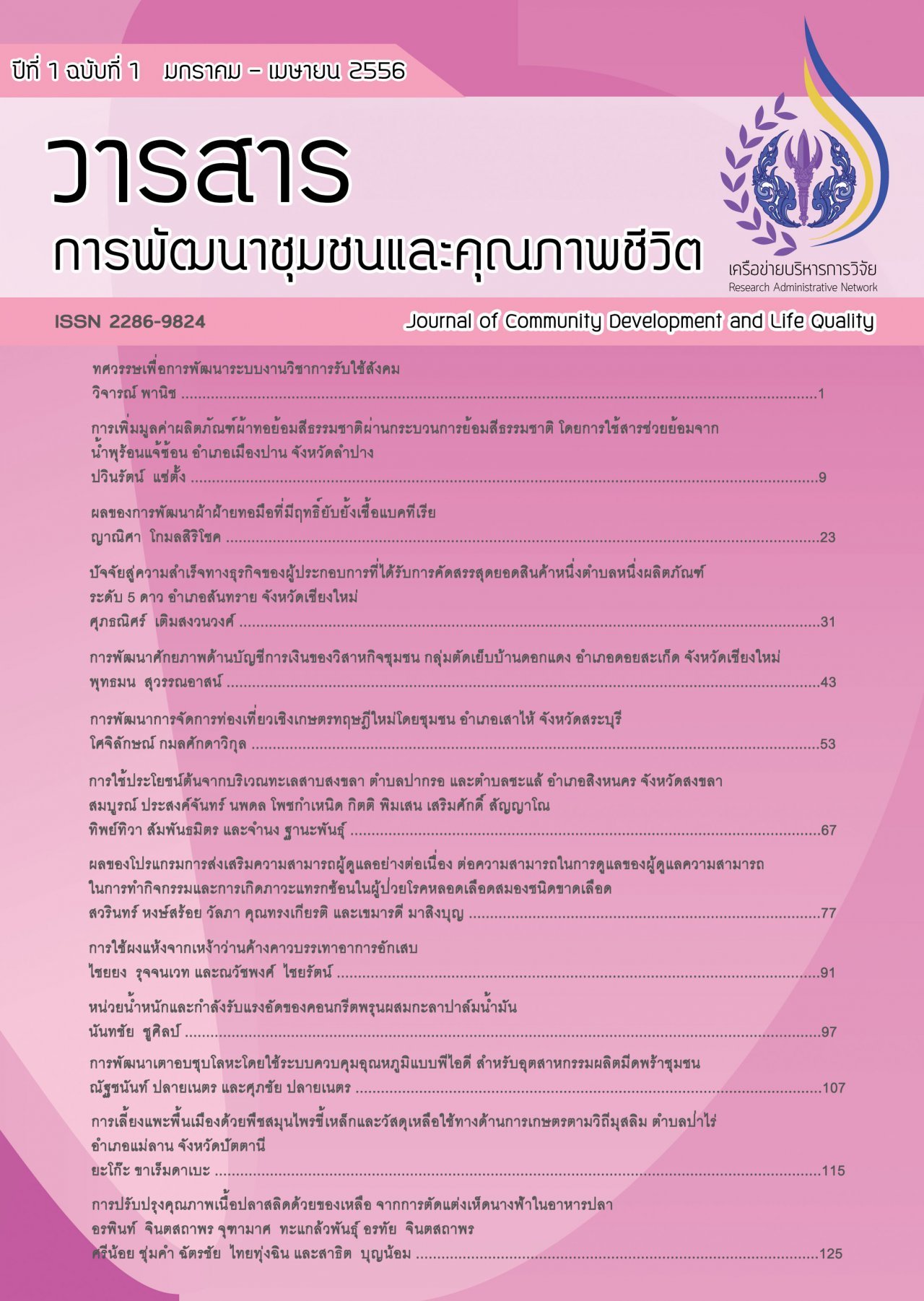การปรับปรุงคุณภาพเนื้อปลาสลิดด้วยของเหลือ จากการตัดแต่งเห็ดนางฟ้าในอาหารปลา
Main Article Content
บทคัดย่อ
การปรับปรุงคุณภาพเนื้อปลาสลิด (Trichogaster pectoralis) โดยการเสริมของเหลือจากการตัดแต่งเห็ดนางฟ้า (Pleurotus sajor-caju) ในอาหารปลาได้ดำเนินการศึกษาโดยมีวัตถุประสงค์เพื่อศึกษาผลของการเสริมของเหลือจากการตัดแต่งเห็ดนางฟ้าในอาหารปลาต่อการเติบโต การใช้ประโยชน์อาหาร และคุณภาพเนื้อปลา หลังการแปรรูปด้วยการทำเค็มตากแห้ง และแช่เย็นที่อุณหภูมิ 4 องศาเซลเซียส เป็นเวลา 72 ชั่วโมง วางแผนการทดลองแบบสุ่มตลอด ประกอบด้วย 3 ชุดการทดลอง ชุดการทดลองละ 4 ซ้ำ ได้แก่ ชุดควบคุมที่ไม่มีการเสริมของเหลือจากการตัดแต่งเห็ดนางฟ้า (T1) และชุดการทดลองที่มีการเสริมของเหลือจากการตัดแต่งเห็ดนางฟ้าสดที่ระดับร้อยละ 5 (T2 เท่ากับ สารสกัดเห็ดนางฟ้า 1%) และการเสริมสารสกัดของเหลือจากการตัดแต่งเห็ดนางฟ้า 1% (T3) ทำการศึกษาเป็นระยะเวลา 2 เดือน พบว่า การเสริมของเหลือจากการตัดแต่งเห็ดนางฟ้าในอาหารปลาสลิดไม่มีผลต่อการเจริญเติบโตและการใช้ประโยชน์อาหารของปลาสลิด (P>0.05) แต่มีผลให้ปริมาณการกินอาหารเพิ่มขึ้น (P≤0.05) และเมื่อสิ้นสุดการทดลองได้นำปลาสลิดไปแปรรูปเป็นปลาสลิดเค็มแห้ง พบว่า ภายหลังการแปรรูปและภายหลังการแช่เย็น 72 ชั่วโมง ค่าการหืนของเนื้อปลาสลิดแปรรูปในกลุ่มที่ได้รับอาหารเสริมสารสกัดของเหลือจากการตัดแต่งเห็ดนางฟ้า 1% มีค่าต่ำกว่า (P≤0.05) กลุ่มควบคุมและกลุ่มที่ได้รับอาหารเสริมของเหลือจากการตัดแต่งเห็ดนางฟ้าสด 5% การทดสอบการยอมรับผลิตภัณฑ์ปลาสลิดเค็มแห้งของผู้บริโภคภายหลังการแปรรูปและปลาสลิดที่แปรรูปแล้วแช่เย็น 72 ชั่วโมง พบว่ามีค่าใกล้เคียงกันในทุกกลุ่มทดลอง เมื่อนำผลการศึกษาไปถ่ายทอดให้กลุ่มเกษตรกรผู้เพาะเลี้ยงปลาสลิดบ้านท่าเรือ ตำบลหนองปลาไหล อำเภอเขาย้อย จังหวัดเพชรบุรี ได้รับความสนใจ และสามารถปฏิบัติตามได้ดี ดังนั้น การเสริมของเหลือจากการตัดแต่งเห็ดนางฟ้าในอาหารปลาสลิดสามารถเพิ่มปริมาณการกินอาหารและปรับปรุงคุณภาพเนื้อปลาสลิดโดยยับยั้งการหืนของเนื้อปลาภายหลังการแปรรูป
Article Details
กองบรรณาธิการขอสงวนสิทธิ์ในการตรวจและแก้ไขบทความที่เสนอเพื่อตีพิมพ์ในวารสารการพัฒนาชุมชนและคุณภาพชีวิต
บทความหรือข้อความคิดเห็นใด ๆ ที่ปรากฏในวารสารการพัฒนาชุมชนและคุณภาพชีวิต เป็นวรรณกรรมของผู้เขียนโดยเฉพาะคณะผู้จัดทำไม่จำเป็นต้องเห็นด้วย และไม่ใช่ความรับผิดชอบของมหาวิทยาลัยและคณะผู้จัดทำ / บรรณาธิการ
References
AOAC. 2000. Official Methods of Analysis. 17th ed. Association of Official Analytical Chemists, Inc., Virginia. 298 p.
Bao, H. N. D., H. Ushio and T. Ohshima. 2008. Antioxidative activity and anti-discoloration efficacy of ergothioneine in mushroom (Flammulina velutipes) extract added to beef and fish meats. Agricultural and Food Chemistry 56: 10032-10040.
Bao, H. N. D., Y. Shinomiya, H. Ikeda and T. Ohshima. 2009. Preventing discoloration and lipid oxidation in dark muscle of yellowtail by feeding an extract prepared from mushroom (Flammulina velutipes) cultured medium. Aquaculture 295: 243-249.
Burk, R. F., M. J. Trumble and R. A. Lawrence. 1980. Rat hepatic cytosolic GSH-dependent enzyme protection against lipid peroxidation in the NADPH microsomal lipid peroxidation system. Biochem. Biophys. Acta 618: 35-41.
Cross, H. R., P. R., Durland and S. C. Seideman. 1986. Sensory qualities of meat. pp. 279-290. In: P. J. Bechtel (ed.). Muscle as Food. Academic Press, Orlando.
Elmastas, M., O. Isildak, I. Turkekul and N. Temur. 2007. Determination of antioxidant activity and antioxidant compounds in wild edible mushroom. Food Composition and Analysis 20: 337-345.
Encarnacion, A. B., F. Fagutao, K. Shozen, I. Hirono and T. Ohshima. 2011. Biochemical intervention of ergothioneine rich edible mushroom (Flammulina velutipes) extract inhibits melanosis in crab (Chionoecetes japonicus). Food Chemistry 127: 1594-1599.
Encarnacion, A. B., F. Fagutao, O. Jintasataporn, W. Worawattanamatee kul, I. Hirono and T. Ohshima. 2012. Application of ergothioneine rich extract from an edible mushroom Flammulina velutipes for melanosis prevention in shrimp, Penaeus monodon and Litopenaeus vannamei. Food Research International 45: 232-237.
Fu, H., D. Shieh and C. Ho. 2002. Antioxidant and free radical scavenging activities of edible mushrooms. Food Lipids 9: 35-46.
Harikrishnan R., C. Balasundarum and M. Heo. 2012. Effect of Inonotus obliquus enriched diet on hematology, immune response, and disease protection in kelp grouper, Epinephelus bruneus against Vibrio harveyi. Aquaculture 344: 48-53.
Jang, M.S., J. Eun , H. Ushio and T. Oshima. 2004. Antioxidative properties of mushroom (Flammulina velutipes) on the oxidation of cod liver oil in emulsion. Food Science Biotechnology 13: 215- 218.
Jayakumar,T., P. A. Thomas, J. R. Sheu and P. Geradine 2011. In-vitro and in-vivo antioxidant effects of the oyster mushroom, Pleurotus ostreatus. Food Research International 44: 851-861.
Khan. Md. A., M. M. Rahman, M. Tania Md. N. Uddin and S. Ahme. 2011. Pleurotus sajor-caju and Pleurotus florida mushrooms improve some extent of the antioxidant systems in the liver of hypercholesterolemic rats. The Open Nutraceuticals Journal 4: 20-24.
NRC. 2011. Nutrient requirements of fish and shrimp. The National Academies Press, Washington, D.C. 376 p.
Paripuranam, T. D., VV. Divya, P. Ulaganathan, V. Balamurugan and S. Umamaheswari. 2011. Replacing fish meal with earthworm and mushroom meals in practical diets of Labeo rohita and Hemigrammus caudovittatus fingerlings. Indian Journal Animal Research 45(2): 115-119.
Pramanik, M., S. Mondal, I. Chakraborty, D. Rout and S. S. Islam. 2005. Structural investigation of a polysaccharide (Fr.II) isolated from the aqueous extract of an edible mushroom, Pleurotus sajor-caju.Carbohydrate Research 340: 629-636.
Pramanik, M, l. Chakraborty, S. Mondal and S. S. Islam 2007. Structural analysis of a water-soluble glucan (Fr.II) of an edible mushroom, Pleurotus sajor-caju . Carbohydrate Research 342: 2670-2675.
Verma, S. M., R. Prasad and N. Kudada. 2001. Investigations of anti-viral properties on extract of Pleurotus sajor-caju. Ancient Science of Life XXI(1): 34-37.

